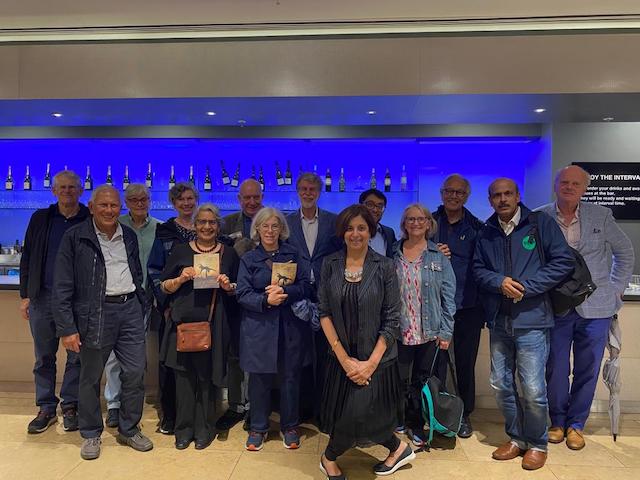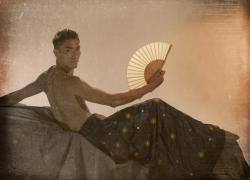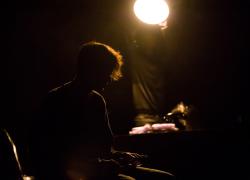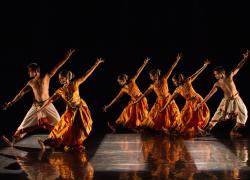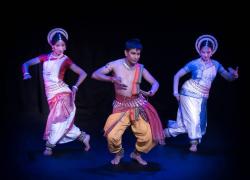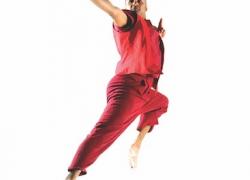Clorinda Agonistes
Clorinda Agonistes (Clorinda the Warrior)
Shobana Jeyasingh Dance
9September 2022
Sadler’s Wells, London
Reviewed by the Pulse Dance Club
Images are screenshots taken from the official trailer.
Who is Clorinda? What is she? The first part of Clorinda Agonistes is set to Monteverdi’s short opera piece for three voices, Il Combattimento (1624). This depicts the combat between Clorinda, a Saracen warrior princess, and the Crusader, Tancredi. Their story had been told by Tasso in his epic poem La Gerusalemme Liberata (1581). Tancredi, unaware that the figure he is fighting is Clorinda, with whom he has fallen in love across the battle lines (though she in turn does not know this), kills her in a fierce battle. The second part of Jeyasingh’s work is brought forward to modern times and set to a specially-commissioned score by the Syrian-American composer Kareem Roustom. Clorinda here is not an individual, but is represented by an ensemble of dancers. There are no surtitles for the librettos (texts), Italian or Arabic. The programme notes that ‘Jeyasingh’s choreography forms its own danced “libretto”’ (Sanjoy Roy).
The quality of the dancing was outstanding throughout, particularly the virtuosity of Jemima Brown (Clorinda) and Jonathan Goddard (Tancredi), matched by the excellence of the ensemble.
The juxtaposition of movement vocabulary in the first half was very powerful: the upright stance and controlled balletic movements of the Crusader Tancredi versus Clorinda's martial arts motifs reinforced a sense of difference. Clorinda was depicted as equally strong here. When she decided to give way, she wasn’t weaker, she just didn’t want to fight any more. It showed her power – this seemed to be the point of the tale here, with the lift at the end bringing a kind of apotheosis.
An unexpected element that challenged the audience to consider the intention of the work was the involvement and intervention of the narrator (the wonderful tenor Ed Lyon): ‘I wasn’t expecting the narrator to roll on the ground and become part of the action’. One commented that it was magical how the singer was incorporated into the dance – a physical presence as well as a musical presence.
Some found that although the dancing of the duel was exhilarating and exciting, the constant rapid pace in the first half was a bit problematic; however, the problem is inherent in Monteverdi – the story is only a fight, so it came in at a high intensity that had to be, and was, maintained.
The dancing in the second half – together with the set and projections – powerfully conjured spaces and images, a montage of fleeing, grieving, resisting. Dancers in headscarves, perhaps never seen before on stage, located the action in the Middle East. The ensemble dancing was active and thrilling, the use of hip-hop dynamic and assertive; and ‘I found the overt phrases of folk dance really enjoyable.’ The dancers grounded the sense of narrative in something more than battle, reinforcing a sense of community. The power, fear, give and take of street protests and battles were very evocative in the contemporary manifestations of the multiple Clorindas. The sense of action was palpable.
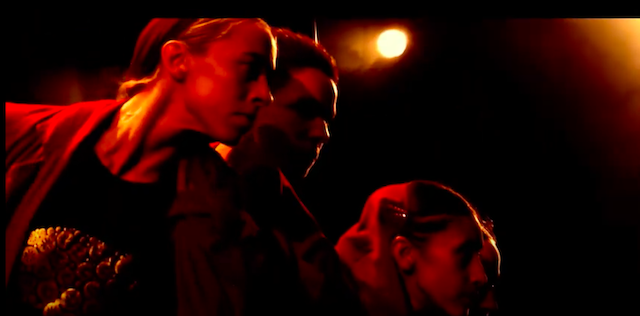
The quality of the music was equal to that of the dance, whether live, in the first half, or as part of a recorded soundscape in the second, with the moving voice of the mezzo soprano, Dima Orsho. There were varied responses to the relationship between the music and the dance. Some found no difficulty in appreciating the dance ‘libretto’ alongside the music and loved the way it could be an opera piece. Others felt that the two were separately so powerful that they competed and some even found the music a distraction from the dance. Whereas dance in opera is generally guided by the opera director, in this case the opera director is not dictating to the choreographer – as with the narrator, this might be seen as another overturning of the usual/expected power structures.
While the singer's integration into the action in the first half had felt seamless, ‘in the second half, I think I was trying to situate the filmmaker and sound tech too specifically, so tried to think of them as parallel to the male characters in the first half. Maybe I was overthinking it.’ This suggests the audience needed a little more help sometimes, though in its own terms, the presence of the detached camera-man and sound operator felt cold and alienating as well as invasive.
There was a general sense that the two halves felt too separate for the flow of the evening. The first half was structured, bound by narrative and the Monteverdi score (even though Jeyasingh referred in the Q & A to creating her own dance score); the second half was created with newly-composed music, with no storyline but presenting a 'montage of images'.
This raised the issue of ‘narrative’ verses ‘non-narrative’. Narrative can give structure, and there are those who like a story; however, others neither want nor need it. Like the move from representational to abstract art, movement can be its own narrative. Jeyasingh was not illustrating the music; but some of the audience felt that there was not sufficient clarity, that one shouldn’t need a Q & A or explanations in the programme notes – one should be able to come to a work without too much prior knowledge and be enveloped, and understand the links between the parts of a work from the work itself.
Listening to the discussion made one aware of how much the collaborators – composer, set, lighting and costume designer – add to the experience of the audience. The changing lights helped shift the sense of location, the columns evoked the classical monumental structures in the first half and they provided spaces to hide and emerge from; then the red lighting of the second brought to mind the losses in battles. Metal flashing, together with the grating sounds of the battlefield and the ‘shing!’ of gunfire evoked the brutality and the sheer terror of being bombed. The film clips made it both general and specific – we found ourselves thinking of so many places of conflict today from Yemen, Syria, Israel-Palestine, to the Ukraine; and of how bombed-out modern cities look the same – it is a shared experience, all too universal, all too constant, devastating and futile. At the same time the story of individuals, with its potential as a love story, was held in our minds from the first part.
The costume worked very well: Clorinda’s royal purple velvet in the first half, and the colours of red, maroon and orange in the second – eye-catching and symbolic of blood, violence and valour – a contrast to the grey horror of the film footage. The long coats over trousers had a flow that added to the movement. The projections of destroyed homes and apartments, with images of processions carrying the dead, gave context to the dance.
Clorinda Agonistes was exciting, exhilarating and took the audience into new territory. Shobana Jeyasingh doesn’t do easy, but the Q & A provided valuable illumination.
The performance that evening was followed by a Q & A with Shobana Jeyasingh, led by Alistair Spalding (Artistic Director and Chief Executive of Sadler’s Wells).
Thank you to those who contributed to the discussion: Robene Dutta, Stacey Prickett, Salim Mehta, Charles Robertson, Mary Pat Robertson, Michael Robertson, Kate Stein and Patricia Yorke. Discussion led by Sanjeevini Dutta. Write-up by Gopa Roy.
The ‘Dance Club’ is an informal grouping of dance professionals and dance and music lovers who attend a performance and share responses afterwards.
